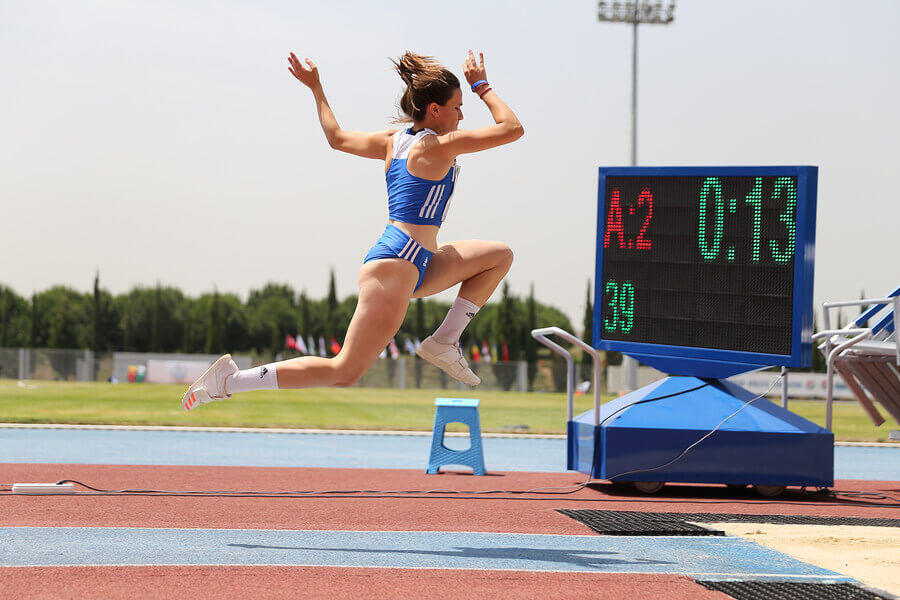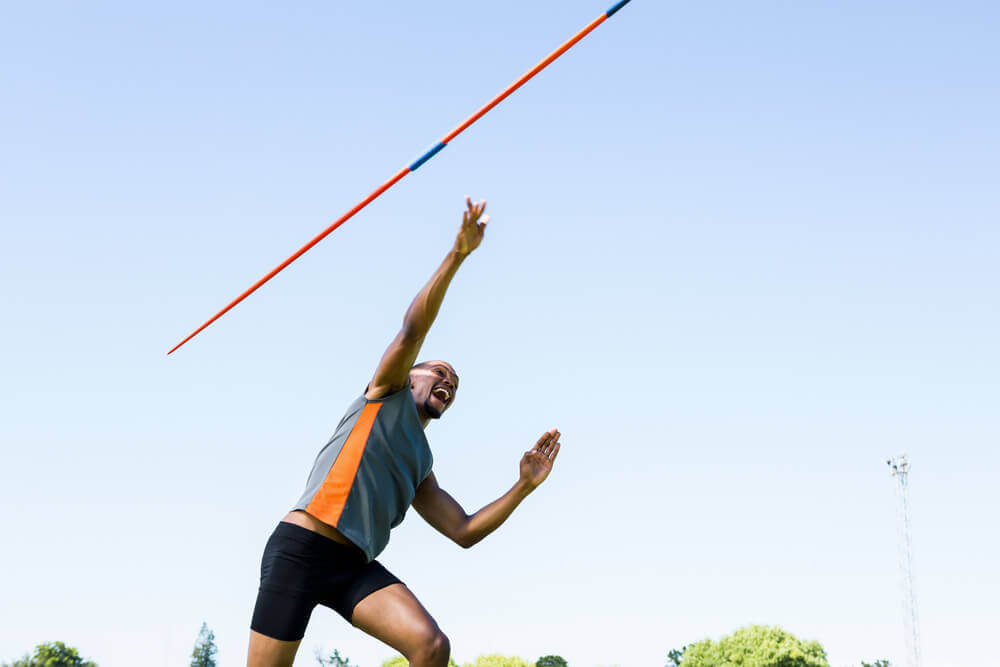5 Track and Field Events

Followed by gymnastics, track and field is the most diverse sport. Many different sports make up track and field, and they’re the most important and anticipated events in the Olympic Games. Learn all about them in our post today!
Which sports are under track and field?
Created in Ancient Greece, track and field is the oldest organized sport in the world. In other languages, track and field translate to “athletics”, which defines the competitors that compete for a prize. In addition, the term closely relates to “aethos“, which means “effort”.
What we know as track and field today is actually a large group of different disciplines with diverse methodologies and objectives. There are five different categories:
1. Foot races
Speed racing is the most common type of foot race and dates back to the Olympic Games of Ancient Greece. Distances can vary between 100 to 400 meters and the participants start at the start line, staying in their own lane.
There are also medium-distance races that range from 800 to 1,500 meters long. And, then there are long-distance races, 5,000 or 10,000 meters, as well. Races with obstacles, hurdles or 4 x 100 or 4 x 400 relays also form part of this first group.

While marathons and field tests aren’t a part of the Olympics, we can’t leave them out of our post. People can practice them both in or out of the stadium.
2. Speed walking
Speed walking has British origins, which date back to 1775, and also form a part of track and field. Unlike foot races, speed walkers move quickly but don’t run.
During the entire race, one foot must always be touching the floor and the supporting leg must be straight. Speed walking races can vary from 20 or 50 kilometers in length.

3. Jumps
Jumps are hands down one of the most intriguing Olympic events thanks to the incredible skill sets of the participating athletes. Nearly all forms of jumping boast some history, as people have been jumping since ancient times. The forms of jumping include:
- Pole vault with a fiberglass pole.
- Long jump: long jump consists of jumping after a running start into a shallow sandpit.
- Triple jump: after a running start, triple jumpers jump once then two more times to cover a long distance.
- High jump: after a running start, high jumpers jump over a horizontal bar backward without knocking it down.

4. Throws
Throwing events are another track and field discipline that are held in the inner-oval of the track. The main objective is to throw an object as far as possible in the least number of attempts.
There are four throwing events: shot put–throwers launch a 7.2-kilogram ball with a running start; discus–today the official discus weighs two kilograms and is 22 centimeters in diameter; hammer–a steel seven-kilogram ball for men and four-kilogram ball for women; and the javelin–a light spear that’s 270 centimeters in length for men and 230 for women.
5. Combined events: all the track and field events merged into one single discipline
Athletes need to boast all the skills required in track and field to attempt combined events. These events have been around since Ancient Greece and aimed to find the man–women didn’t participate in those times– most akin to the Gods.

The modern pentathlon includes five events: fencing, equestrian show jumping, freestyle swimming, pistol shooting and cross-country running. Meanwhile, a heptathlon consists of seven events: 100-meter hurdles, high jump, shot put and 200-meters on the first day of the competition; and the long jump, javelin throw and 800-meters on the second.
Lastly, there’s the decathlon, which includes 10 events. On the first day, competitors push through the 100-meters, long jump, shot put, high jump and 400-meters. Then on the second day, they tackle the 110-meter hurdles, discus throw, pole vault, javelin throw, and the 1,500-meters.
All of these sports are recognized and organized by the World Athletics. So, which one’s your favorite?
Followed by gymnastics, track and field is the most diverse sport. Many different sports make up track and field, and they’re the most important and anticipated events in the Olympic Games. Learn all about them in our post today!
Which sports are under track and field?
Created in Ancient Greece, track and field is the oldest organized sport in the world. In other languages, track and field translate to “athletics”, which defines the competitors that compete for a prize. In addition, the term closely relates to “aethos“, which means “effort”.
What we know as track and field today is actually a large group of different disciplines with diverse methodologies and objectives. There are five different categories:
1. Foot races
Speed racing is the most common type of foot race and dates back to the Olympic Games of Ancient Greece. Distances can vary between 100 to 400 meters and the participants start at the start line, staying in their own lane.
There are also medium-distance races that range from 800 to 1,500 meters long. And, then there are long-distance races, 5,000 or 10,000 meters, as well. Races with obstacles, hurdles or 4 x 100 or 4 x 400 relays also form part of this first group.

While marathons and field tests aren’t a part of the Olympics, we can’t leave them out of our post. People can practice them both in or out of the stadium.
2. Speed walking
Speed walking has British origins, which date back to 1775, and also form a part of track and field. Unlike foot races, speed walkers move quickly but don’t run.
During the entire race, one foot must always be touching the floor and the supporting leg must be straight. Speed walking races can vary from 20 or 50 kilometers in length.

3. Jumps
Jumps are hands down one of the most intriguing Olympic events thanks to the incredible skill sets of the participating athletes. Nearly all forms of jumping boast some history, as people have been jumping since ancient times. The forms of jumping include:
- Pole vault with a fiberglass pole.
- Long jump: long jump consists of jumping after a running start into a shallow sandpit.
- Triple jump: after a running start, triple jumpers jump once then two more times to cover a long distance.
- High jump: after a running start, high jumpers jump over a horizontal bar backward without knocking it down.

4. Throws
Throwing events are another track and field discipline that are held in the inner-oval of the track. The main objective is to throw an object as far as possible in the least number of attempts.
There are four throwing events: shot put–throwers launch a 7.2-kilogram ball with a running start; discus–today the official discus weighs two kilograms and is 22 centimeters in diameter; hammer–a steel seven-kilogram ball for men and four-kilogram ball for women; and the javelin–a light spear that’s 270 centimeters in length for men and 230 for women.
5. Combined events: all the track and field events merged into one single discipline
Athletes need to boast all the skills required in track and field to attempt combined events. These events have been around since Ancient Greece and aimed to find the man–women didn’t participate in those times– most akin to the Gods.

The modern pentathlon includes five events: fencing, equestrian show jumping, freestyle swimming, pistol shooting and cross-country running. Meanwhile, a heptathlon consists of seven events: 100-meter hurdles, high jump, shot put and 200-meters on the first day of the competition; and the long jump, javelin throw and 800-meters on the second.
Lastly, there’s the decathlon, which includes 10 events. On the first day, competitors push through the 100-meters, long jump, shot put, high jump and 400-meters. Then on the second day, they tackle the 110-meter hurdles, discus throw, pole vault, javelin throw, and the 1,500-meters.
All of these sports are recognized and organized by the World Athletics. So, which one’s your favorite?
All cited sources were thoroughly reviewed by our team to ensure their quality, reliability, currency, and validity. The bibliography of this article was considered reliable and of academic or scientific accuracy.
- Sant, J. R. (2005). 2017. Metodología y técnicas de Atletismo. Editorial Paidotribo.
This text is provided for informational purposes only and does not replace consultation with a professional. If in doubt, consult your specialist.








